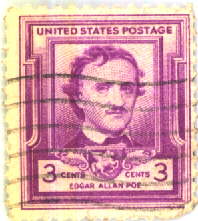Edgar Allan Poe
 Edgar Allan Poe, a southerner, shares with Melville a darkly
metaphysical vision mixed with elements of realism, parody, and
burlesque. He refined the short story genre and invented
detective fiction. Many of his stories prefigure the genres of
science fiction, horror, and fantasy so popular today.
Edgar Allan Poe, a southerner, shares with Melville a darkly
metaphysical vision mixed with elements of realism, parody, and
burlesque. He refined the short story genre and invented
detective fiction. Many of his stories prefigure the genres of
science fiction, horror, and fantasy so popular today.
Poe's short and tragic life was plagued with insecurity. Like so many other major 19th-century American writers, Poe was orphaned at an early age. Poe's strange marriage in 1835 to his first cousin Virginia Clemm, who was not yet 14, has been interpreted as an attempt to find the stable family life he lacked.
Poe believed that strangeness was an essential ingredient of beauty, and his writing is often exotic. His stories and poems are populated with doomed, introspective aristocrats (Poe, like many other southerners, cherished an aristocratic ideal). These gloomy characters never seem to work or socialize; instead they bury themselves in dark, moldering castles symbolically decorated with bizarre rugs and draperies that hide the real world of sun, windows, walls, and floors. The hidden rooms reveal ancient libraries, strange art works, and eclectic oriental objects. The aristocrats play musical instruments or read ancient books while they brood on tragedies, often the deaths of loved ones. Themes of death-in-life, especially being buried alive or returning like a vampire from the grave, appear in many of his works, including "The Premature Burial," "Ligeia," "The Cask of Amontillado," and "The Fall of the House of Usher." Poe's twilight realm between life and death and his gaudy, Gothic settings are not merely decorative. They reflect the overcivilized yet deathly interior of his characters disturbed psyches. They are symbolic expressions of the unconscious, and thus are central to his art.
Poe's verse, like that of many Southerners, was very musical and strictly metrical. His best-known poem, in his own lifetime and today, is "The Raven" (1845). In this eerie poem, the haunted, sleepless narrator, who has been reading and mourning the death of his "lost Lenore" at midnight, is visited by a raven (a bird that eats dead flesh, hence a symbol of death) who perches above his door and ominously repeats the poem's famous refrain, "nevermore." The poem ends in a frozen scene of death-in-life:
is sitting, still is sitting
On the pallid bust of Pallas just
above my chamber door;
And his eyes have all the seeming of
a demon's that is dreaming,
And the lamp-light o'er him
streaming throws his shadow on the
floor;
And my soul from out that shadow
that lies floating on the floor
Shall be lifted -- nevermore!
Poe's stories -- such as those cited above -- have been described as tales of horror. Stories like "The Gold Bug" and "The Purloined Letter" are more tales of ratiocination, or reasoning. The horror tales prefigure works by such American authors of horror fantasy as H.P. Lovecraft and Stephen King, while the tales of ratiocination are harbingers of the detective fiction of Dashiell Hammett, Raymond Chandler, Ross Macdonald, and John D. MacDonald. There is a hint, too, of what was to follow as science fiction. All of these stories reveal Poe's fascination with the mind and the unsettling scientific knowledge that was radically secularizing the 19th-century world view.
In every genre, Poe explores the psyche. Profound psychological insights glint throughout the stories. "Who has not, a hundred times, found himself committing a vile or silly action, for no other reason than because he knows he should not," we read in "The Black Cat." To explore the exotic and strange aspect of psychological processes, Poe delved into accounts of madness and extreme emotion. The painfully deliberate style and elaborate explanation in the stories heighten the sense of the horrible by making the events seem vivid and plausible.
Poe's combination of decadence and romantic primitivism appealed enormously to Europeans, particularly to the French poets Stéphane Mallarmé, Charles Baudelaire, Paul Valéry, and Arthur Rimbaud. But Poe is not un-American, despite his aristocratic disgust with democracy, preference for the exotic, and themes of dehumanization. On the contrary, he is almost a textbook example of Tocqueville's prediction that American democracy would produce works that lay bare the deepest, hidden parts of the psyche. Deep anxiety and psychic insecurity seem to have occurred earlier in America than in Europe, for Europeans at least had a firm, complex social structure that gave them psychological security. In America, there was no compensating security; it was every man for himself. Poe accurately described the underside of the American dream of the self-made man and showed the price of materialism and excessive competition -- loneliness, alienation, and images of death-in-life.
Poe's "decadence" also reflects the devaluation of symbols that occurred in the 19th century -- the tendency to mix art objects promiscuously from many eras and places, in the process stripping them of their identity and reducing them to merely decorative items in a collection. The resulting chaos of styles was particularly noticeable in the United States, which often lacked traditional styles of its own. The jumble reflects the loss of coherent systems of thought as immigration, urbanization, and industrialization uprooted families and traditional ways. In art, this confusion of symbols fueled the grotesque, an idea that Poe explicitly made his theme in his classic collection of stories, Tales of the Grotesque and Arabesque (1840).
